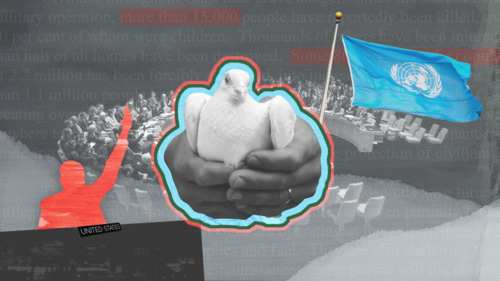How the US has Used its Power in the UN to Support Israel for Decades

The US has used its UN veto power to stop an Israel-Hamas war ceasefire resolution and other measures. Here's how it got veto power and how America has used it.
In short: The United Nations General Assembly passed a resolution on Dec. 12 that called for a cease-fire in the Israel-Hamas war amid an intensifying humanitarian crisis in the Gaza Strip. The General Assembly resolution came after the U.N. Security Council, the only body in the U.N. with the power to pass legally binding resolutions, was unable to pass a cease-fire resolution because the U.S. blocked it. The U.S. has a long history of using its Security Council veto to support Israel.
How does the General Assembly's power differ from the Security Council's?
The U.N. General Assembly includes representatives from all 193 member countries, but its resolutions are not legally binding. The Security Council is a 15-member group within the U.N. tasked with maintaining international peace, and its resolutions are legally binding. The council’s powers include the ability to tell U.N. members to sanction entities or individuals and to “take military action against an aggressor.”
The five permanent council members – the U.S., the U.K., Russia, China, and France – also have the power to veto any resolution, which limits what the council can do to end conflicts that involve a permanent member or an ally of a permanent member, as in the case of the Israel-Hamas war or the Russian invasion of Ukraine.
A 2002 analysis found that, at the time, at least 91 Security Council resolutions were being ignored. Israel and Turkey were ignoring the most, with 31 and 23 violations, respectively, according to research reported by the Los Angeles Times. Many of the resolutions Israel was ignoring pertained to its occupation of Palestinian territory.
There are also 10 rotating members of the Security Council, which are elected by the General Assembly for two-year terms. The current rotating members are Albania, Brazil, Ecuador, Gabon, Ghana, Japan, Malta, Mozambique, Switzerland, and the United Arab Emirates.
How did council members get veto power?
The veto power was offered to the five permanent members when the U.N. and Security Council were created in 1945 in the aftermath of World War II. The U.N. director for the International Crisis Group, Richard Gowan, told CNN that offering these countries the ability to protect themselves from Security Council resolutions was the only way President Franklin D. Roosevelt could get them to join the U.N.
However, the veto has hindered the Security Council’s ability to act in accordance with the majority’s views. For example, when Russia invaded Ukraine in 2022, any Security Council resolutions meant to sanction or condemn Russia could be vetoed by Russia itself.
How has the veto been used during the Israel-Hamas war?
In addition to vetoing the Dec. 8 cease-fire resolution, the U.S. vetoed an Oct. 18 resolution calling for “humanitarian pauses.” The latter vote happened during President Joe Biden’s trip to Israel, and the U.S. delegate on the Security Council said the council needed to let U.S. diplomacy “play out.” The delegate expressed disappointment that the resolution draft didn’t condone Israel’s right to self-defense.
Russia and China also vetoed an Oct. 25 resolution backed by the U.S. The resolution demanded the immediate release of the hostages taken by Hamas and called for “all measures” to be taken to allow humanitarian aid into Gaza, including humanitarian pauses. The Chinese representative on the council said they vetoed it because the resolution didn’t call for a cease-fire, a sentiment Russia reflected in a cease-fire resolution it brought to the council after China and Russia vetoed the U.S. resolution.
How has the U.S. used its veto power to support Israel?
The U.S. has vetoed resolutions critical of Israel more than any other council member – 45 times as of December 18, 2023, according to an analysis by Blue Marble. The U.S. has vetoed 89 Security Council resolutions in total since 1945, meaning slightly over half of its vetoes have been used on resolutions critical of Israel. Of the vetoed resolutions, 33 pertained to the Israeli occupation of Palestinian territories or the country’s treatment of the Palestinian people.
The first time the U.S. used its veto to support Israel was in September of 1972, when it vetoed a resolution that called on Israel to cease its aggression in Lebanon. This was the second time the U.S. had ever used its Security Council veto; the first was on a resolution regarding Southern Rhodesia. After that, the U.S. used its veto to halt resolutions critical of Israel frequently. Between 1982 and 1990, the U.S. used its veto in support of Israel 21 times – nearly half of the U.S.’s total vetoes in support of Israel. The vetoed resolutions criticized Israel’s aggression in Lebanon and its occupation of Palestinian territories.
Since 2001, the U.S. has used its veto in support of Israel 14 times.

